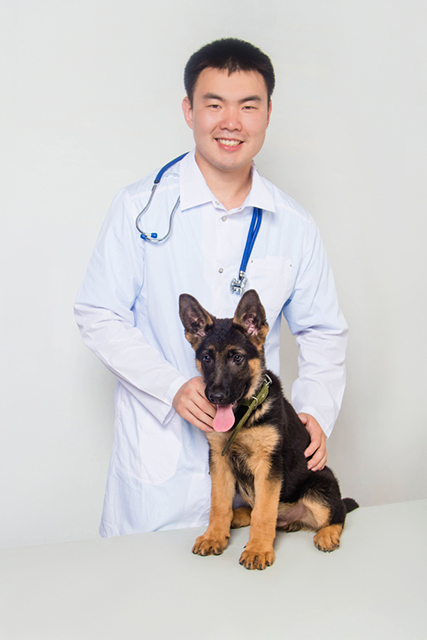FUNNY NAME FOR A DISEASE IN ANIMALS, BUT NOT A FUNNY DISEASE
As a generalist – that is, a veterinar-ian who is not invested in any par-ticular specialization – I am familiar with the specialist-versus-generalist debate. Rather than settling it by saying it depends, the better answer is, since we need both types, then each of us needs to be both types. In order to save as many animal lives and stay employable in the future, we need to both broaden and deepen our skill and knowledge.
The field of Veterinary Medicine is vast and var-ied. And once an animal emergency exists, it stops mattering whether one is a generalist or a special-ist. What matters more is knowing how to deal with these emergencies, so that one can save the life of an animal.

One such emergency I encoun-ter is a dog having seizures. Whenever a canine comes in with seizures, in my brain, it’s all systems go, just like the preliminary launch sequence at NASA. Similar to how the systems check ensues there, my brain also carries out a similar checklist, and the response is a series of affirmatives, including the basic ABCs, which stands for Airway, Breathing, and Cir-culation.
In between the frenzied shout-ing for equipment, lab tests, and medication, what fuels me is more than adrenaline. For me, it as both a privilege and an obligation to be in a field that makes it possible for me to treat a dog who is seizing. There is a need to focus, even as blood, sweat, and tears become part of the scenario.
As you address the seizing dog, you start wonder-ing, is this heatstroke? Has it progressed to status epilepticus? Is it because of traumatic brain injury? Or is this seizure cause by some metabolic problem?

A CURIOUS CASE OF CONVULSION
There was one such dog who was rushed to the clinic. As I talked to the humans caring for her, I asked them the usual questions. There was no history of head trauma and the like; however, the female dog had just given to six puppies four weeks ago. Bingo.
They said that she was fine just a few minutes ago, then all of a sudden, she started to stiffen, salivate, and show signs of mental confusion. She could no longer stand, and she started con-vulsing. She was warm to touch, and a tempera-ture check revealed that she had a raging fever of 42°C.
I said to myself, “This isn’t heatstroke. This is hypocalcemic tetany.” Her condition is also known as milk fever or eclampsia.

MILK FEVER BASICS
No, milk fever is not cause by a dog drinking milk. Here are a few things you might want to know about this life-threatening condition.
WHAT IS MILK FEVER?
Milk fever, a funny name to call canine puerperal tetany or ec-lampsia, occurs when calcium levels in the blood are low after a dog gives birth. When calcium is transferred from the mother dog to her babies without being replenished, a drop in calcium levels occurs, which can be fatal if not treated.

MILK FEVER IS A MEDICAL EMERGENCY!
Milk fever can be fatal within thirty minutes after man-ifestations set in. Prompt diagnosis and treatment are necessary to save the life of a female dog who has it.
WHAT CAUSES MILK FEVER IN DOGS?
According to Animal Emergency Service, here are some of the reasons a female canine develops milk fever.
1. A dog doesn’t eat a balanced diet
2. A mother dog produces milk without being able to keep up with calcium demands
3. A dog’s albumin levels are too low, disrupting the transport of calcium
4. There is too much calcium supplementation before a dog gives birth
5. There are problems with a dog’s parathyroid gland
WHAT ARE THE SIGNS OF MILK FEVER?
Milk fever starts as panting, restlessness, drooling, vomiting, loss of appetite, and stiffness. Later, the condition pro-gresses, and manifestations include tremors, seizures, coordination problems, inability to stand, high fever, and even heat stroke in those with excessive tremors.
WHO ARE PRONE TO MILK FEVER?
Small breed dogs who give birth to a big litter are predis-posed to developing milk fever. These dogs include Mini Pinschers, Miniature Poodles, Chihuahuas, and Shih- Tzus.
Dogs who were diagnosed with milk fever in the past are also prone to having it again, and so are female puppies born by dogs with milk fever once they give birth them-selves.

CARING FOR A CONVULSING CANINE
I went back to my ABCs and inverted it: Circulation, Breathing, Airway. It was the worst three minutes of my life. Other than the fact that the poor mother dog was convulsing, I was already a hemiplegic. Her saliva was all over my face, clouding my vision. I knew I was a person with disability, but I had sworn never to shrink away from seemingly overwhelming emergencies, except surgeries that I was no longer capable of performing.
I inserted a needle for an intravenous line. I administered medication that would help alleviate the dog’s suffering. I also gave her calcium, at a dose which was a fraction recommended for her weight, via intramuscular injection.
An hour later, the dog stopped convulsing. She was still disoriented, but she started responding to her name. It was far from over, but the urgency of the situation had begun to ebb.
I explained to the dog’s humans what milk fever was. It was a metabolic problem, with possible concurrent and underlying conditions, such as pancreatitis, protein-losing enteropathies, parathyroid disease, and trauma. It is best not to be too confident as one cares for the recovery of a dog with milk fever.
I also explained that it could recur with subsequent litters.

PRACTICAL REMINDERS
If a dog under your care is pregnant, here are a few reminders.
1. Avoid high phytate feeds or dog food made of soybeans.
2. Do not supplement with high calcium multivitamins marketed for obstetrics.
3. Do not give dog food with high phosphorus content (high-protein diets are usually high in phosphorus).
4. During the first two weeks of lactation, give puppy food to provide sufficient metabolizable energy for lactation.
5. Remember that mindless supplementation with commercial vitamins during pregnancy can do more harm than good. Maintenance food may be enough to meet the needs of a pregnant dog.
Dr. Emmanuel D. Macapagal is the 2000-2001 president of the Philippine Animal Hospital Association, Inc.






